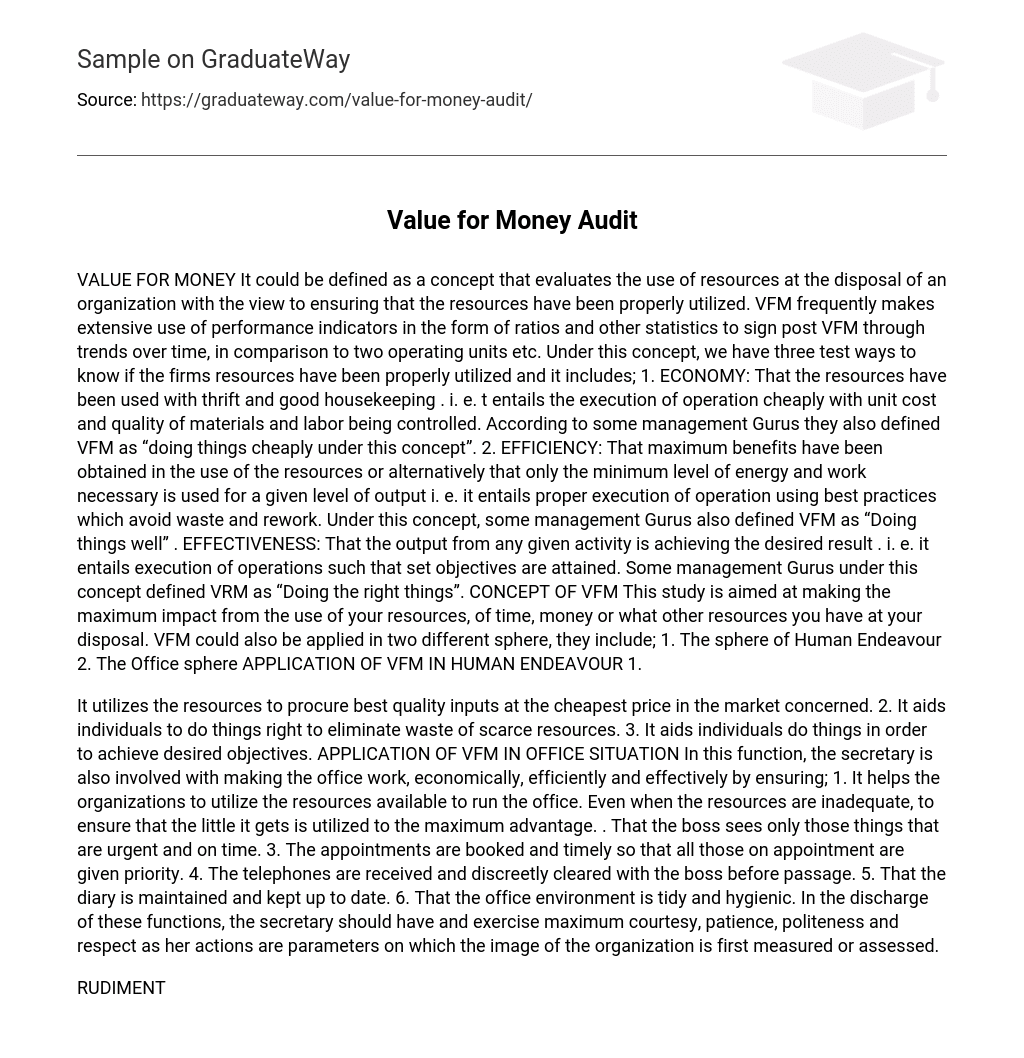VALUE FOR MONEY It could be defined as a concept that evaluates the use of resources at the disposal of an organization with the view to ensuring that the resources have been properly utilized. VFM frequently makes extensive use of performance indicators in the form of ratios and other statistics to sign post VFM through trends over time, in comparison to two operating units etc. Under this concept, we have three test ways to know if the firms resources have been properly utilized and it includes; 1. ECONOMY: That the resources have been used with thrift and good housekeeping . i. e. t entails the execution of operation cheaply with unit cost and quality of materials and labor being controlled. According to some management Gurus they also defined VFM as “doing things cheaply under this concept”. 2. EFFICIENCY: That maximum benefits have been obtained in the use of the resources or alternatively that only the minimum level of energy and work necessary is used for a given level of output i. e. it entails proper execution of operation using best practices which avoid waste and rework. Under this concept, some management Gurus also defined VFM as “Doing things well” . EFFECTIVENESS: That the output from any given activity is achieving the desired result . i. e. it entails execution of operations such that set objectives are attained. Some management Gurus under this concept defined VRM as “Doing the right things”. CONCEPT OF VFM This study is aimed at making the maximum impact from the use of your resources, of time, money or what other resources you have at your disposal. VFM could also be applied in two different sphere, they include; 1. The sphere of Human Endeavour 2. The Office sphere APPLICATION OF VFM IN HUMAN ENDEAVOUR 1.
It utilizes the resources to procure best quality inputs at the cheapest price in the market concerned. 2. It aids individuals to do things right to eliminate waste of scarce resources. 3. It aids individuals do things in order to achieve desired objectives. APPLICATION OF VFM IN OFFICE SITUATION In this function, the secretary is also involved with making the office work, economically, efficiently and effectively by ensuring; 1. It helps the organizations to utilize the resources available to run the office. Even when the resources are inadequate, to ensure that the little it gets is utilized to the maximum advantage. . That the boss sees only those things that are urgent and on time. 3. The appointments are booked and timely so that all those on appointment are given priority. 4. The telephones are received and discreetly cleared with the boss before passage. 5. That the diary is maintained and kept up to date. 6. That the office environment is tidy and hygienic. In the discharge of these functions, the secretary should have and exercise maximum courtesy, patience, politeness and respect as her actions are parameters on which the image of the organization is first measured or assessed.
RUDIMENTS OF VFM AUDITS The United Kingdom Audit Commission handbook identifies six interrelated main elements of organization effectiveness which need to be managed to re-enforce each other and to reflect political priorities; 1. VISION AND STRATEGY: It is the guiding concept or statement concerning future areas of organizational activity. It may take the form of a corporate statement of policy objectives. This statement should consider the manner in which the objectives can be achieved, allowing for changing circumstances.
Such a plan must be subjected to continuous monitoring to match the changing environment. 2. STRUCTURE: It is the framework which enables objectives to be analyzed into separate functions. Differing needs require different structures and as such, they include; •Simplicity-fewer committees may lead to quicker decisions. •The management structure should support the committee structure. •Clear identification of tasks. •Individual accountability. 3. SYSTEMS: Management systems are procedures that make an organization to function properly and as such, they include; Procedures for reviewing objectives and evaluating performance in the light of changing circumstances. •Monitoring procedures to show whether progress is being made in the direction intended. •Planning procedures for allocating resources and assigning individual objectives. 4. STAFFING AND SKILLS: Changes in strategy, structure or system to match changed circumstances often required new skills. Having the right staff in the right jobs at the right time, properly trained and instructed and well motivated, is most likely to enable improvements to be achieved in economy, efficiency and effectiveness.
STRUCTURE FOR VFM AUDIT The structures VFM include the following; 1. Identifying the key policy objectives. 2. Establishing that the organizational structures appropriate 3. Establishing that line managers fully understand and implement policy as defined and intended by senior management 4. Validating performance indicators 5. Examining the activities of each selection of the organization as measure against the objectives adopted. 6. Ensuring that the information reaching the decision makers is reliable and adequate for all options to be reasonably appraised.
TECHNIQUES APPLIED IN VFM AUDITS: Such techniques include; 1. Value analysis 2. Functional cost analysis 3. Cost reduction programme 4. Inter-organization comparison 5. Goal analysis 6. System reviews 7. Input based review 8. System based studies 9. Output based studies 10. Terrotechnology AUDIT REQUIREMENTS 1. Independence from operational departments 2. Professionalism in execution 3. Systematic approach 4. Adequate timescale 5. Adequate method of analysis 6. Sound conclusion and feasible recommendations. NAME:OGODETON KELVIN OKIEMUTE DEPT:ACCOUNTING





